
Color, 1976, 84/81m.
Directed by Henry Paris (Radley Metzger)
Starring Constance Money, Jamie Gillis, Jacqueline Beaudant, Terri Hall, Calvin Culver, Ras Kean, Gloria Leonard
Distribpix (Blu-Ray & DVD) (US R0 HD/NTSC) / WS (1.85:1) (16:9) / DTS-HD5.1,
VCA (US R0 NTSC)
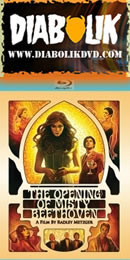
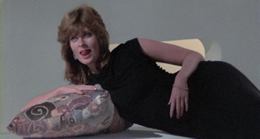
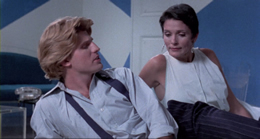 sty about her lack of experience. Striking up a bet with his partner Geraldine (one-shot wonder Beaudant), Seymour wagers he can turn Misty into the toast of the town as the revered Golden Rod Girl at the next high society party thrown by vain magazine publisher Lawrence Layman (Kean) and his wife, Barbara (Leonard). Seymour, Geraldine, and Misty jet off to New York and Europe where he instructs his pupil in the arts of pleasure and sends her out to build her reputation with a variety of men, including a mostly gay art dealer played by Score's Calvin Culver. As Misty's fame spreads, Seymour's arrogance conceals a growing attraction to his ugly duckling.. but can he still have her?
sty about her lack of experience. Striking up a bet with his partner Geraldine (one-shot wonder Beaudant), Seymour wagers he can turn Misty into the toast of the town as the revered Golden Rod Girl at the next high society party thrown by vain magazine publisher Lawrence Layman (Kean) and his wife, Barbara (Leonard). Seymour, Geraldine, and Misty jet off to New York and Europe where he instructs his pupil in the arts of pleasure and sends her out to build her reputation with a variety of men, including a mostly gay art dealer played by Score's Calvin Culver. As Misty's fame spreads, Seymour's arrogance conceals a growing attraction to his ugly duckling.. but can he still have her?
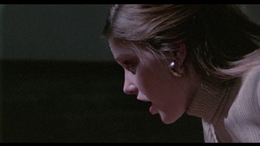 disc includes some nifty extras, the most notable being a running feature commentary by Gillis and Leonard. Obviously old pals, the two dish out an amazing number of anecdotes about the film, many of them involving the notoriously uncooperative Money. Leonard also drops a couple of curve balls including the revelation that she slept with Metzger (once) and a reference to the actual name of this film's cinematographer, "Robert Rochester," who turned out to be Paul Glickman . A couple of factual go
disc includes some nifty extras, the most notable being a running feature commentary by Gillis and Leonard. Obviously old pals, the two dish out an amazing number of anecdotes about the film, many of them involving the notoriously uncooperative Money. Leonard also drops a couple of curve balls including the revelation that she slept with Metzger (once) and a reference to the actual name of this film's cinematographer, "Robert Rochester," who turned out to be Paul Glickman . A couple of factual go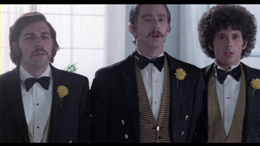 ofs aside (Leonard insists Calvin Culver and Casey Donovan weren't the same person, and Gillis erroneously refers to this as his first film for Metzger), the commentary makes for an enlightening and joyous experience. Other goodies include a gallery of promotional stills for this film and Barbara Broadcast, a three-minute reflection by Jim Holliday, and some promotional filler for VCA products.
ofs aside (Leonard insists Calvin Culver and Casey Donovan weren't the same person, and Gillis erroneously refers to this as his first film for Metzger), the commentary makes for an enlightening and joyous experience. Other goodies include a gallery of promotional stills for this film and Barbara Broadcast, a three-minute reflection by Jim Holliday, and some promotional filler for VCA products.
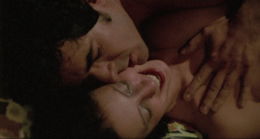 And now we get to the rest of the extras, which should keep fans busy for many hours. The explicit cut contains another excellent commentary with Metzger and moderator Benson Hurst, covering such topics as the origins of the project, the evolution of the title, all of the cast members, and the tactics used to give the film an international, jet-setting flavor. (Oh, and that great Roman mansion seen in the film? That was really in New Jersey.) On the other hand, the softcore version has a solo commentary with Leonard, which plays a bit differently from her one with Gillis on the previous release. The future publisher of High Society spends a lot of time offering her own blow-by-blow coverage of the events in the film, but she has plenty of perceptive comments to make about Metzger's directorial style and her own views on how to present pornography on celluloid. "Behind the Scenes of Misty Beethoven" offers an impressive 48-minute look at the creation of the film with Metzger (audio only, as usual) and Leonard returning to the talk about the film's genesis and production. However, the biggest bonus here is the new interview footage with cinematographer Glickman, who also lensed several films by Al Adamson (The Female Bunch, Dracula vs. Frankenstein) and Larry Cohen (God Told Me To,
And now we get to the rest of the extras, which should keep fans busy for many hours. The explicit cut contains another excellent commentary with Metzger and moderator Benson Hurst, covering such topics as the origins of the project, the evolution of the title, all of the cast members, and the tactics used to give the film an international, jet-setting flavor. (Oh, and that great Roman mansion seen in the film? That was really in New Jersey.) On the other hand, the softcore version has a solo commentary with Leonard, which plays a bit differently from her one with Gillis on the previous release. The future publisher of High Society spends a lot of time offering her own blow-by-blow coverage of the events in the film, but she has plenty of perceptive comments to make about Metzger's directorial style and her own views on how to present pornography on celluloid. "Behind the Scenes of Misty Beethoven" offers an impressive 48-minute look at the creation of the film with Metzger (audio only, as usual) and Leonard returning to the talk about the film's genesis and production. However, the biggest bonus here is the new interview footage with cinematographer Glickman, who also lensed several films by Al Adamson (The Female Bunch, Dracula vs. Frankenstein) and Larry Cohen (God Told Me To, 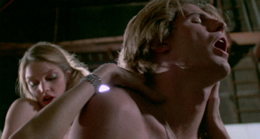 The Stuff) as well as Pamela Mann. His comments about merging his work as a magician with his craft are fascinating, and it's great to see his love and enthusiasm for this film years later. Also present are music supervisor George Craig, who gathered up all the incredible library music for this film, and sex specialists Drs. Carol Queen and Robert Lawrence, who appear near the end (appropriately) to talk about the film's pioneering depiction of pegging. Also included are a wealth of behind-the-scenes photographs, some of which fly by all too quickly.
The Stuff) as well as Pamela Mann. His comments about merging his work as a magician with his craft are fascinating, and it's great to see his love and enthusiasm for this film years later. Also present are music supervisor George Craig, who gathered up all the incredible library music for this film, and sex specialists Drs. Carol Queen and Robert Lawrence, who appear near the end (appropriately) to talk about the film's pioneering depiction of pegging. Also included are a wealth of behind-the-scenes photographs, some of which fly by all too quickly.